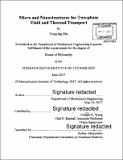Micro and nanostructures for two-phase fluid and thermal transport
Author(s)
Zhu, Yangying
DownloadFull printable version (13.81Mb)
Other Contributors
Massachusetts Institute of Technology. Department of Mechanical Engineering.
Advisor
Evelyn N. Wang.
Terms of use
Metadata
Show full item recordAbstract
This thesis aims to develop fundamental understanding of the role of surface structures in two-phase heat sinks including capillary driven evaporators and flow boiling in microchannels. First, we developed a detailed finite volume numerical model for thin-film evaporation from micropillar array wick structures. The model can predict the dry-out heat flux on various micropillar structure geometries (diameter, pitch, and height) in the length scale range of 1-100 pm and capture the optimal geometries to maximize the dry-out heat flux. The model suggests that maximizing the capillary flow requires a high capillary pressure gradient and a low viscous flow resistance, and that only considering one factor can lead to a low dry-out heat flux. Guided by the model, we then designed and fabricated microchannel heat sink devices incorporated with surface structures. Specifically, we decouple nucleation and thin film evaporation through the design of two different surfaces on the sidewall and the heated bottom surface. Bubbles can be generated at the less hydrophilic sidewalls while the superhydrophilic microstructures on the heated surface of the channel can maintain a liquid film by capillary wicking to promote thin film evaporation and prevent dry-out. Our experimental results show significantly reduced long-timescale (-seconds) temperature and pressure drop fluctuation at high heat fluxes. A critical heat flux (CHF) of 969 W/cm2 was achieved with a structured surface, a 57% enhancement compared to a smooth surface. The trend of CHF enhancement among different geometries of the structures agrees well with the fluid wicking model, which suggests that capillarity is the key factor contributing to the enhanced performance. Furthermore, we investigated the temperature response as a result of short-timescale (-ms) flow oscillation. The surface structures also significantly suppress the magnitude of this high-frequency temperature oscillation and potentially can improve the reliability of these two-phase heat sinks with reduced mechanical and thermal fatigue. The insights gained from these works lead to new design principles for advanced thermal management solutions for high power density electronic systems in the future.
Description
Thesis: Ph. D., Massachusetts Institute of Technology, Department of Mechanical Engineering, 2017. Cataloged from PDF version of thesis. Includes bibliographical references (pages 91-96).
Date issued
2017Department
Massachusetts Institute of Technology. Department of Mechanical EngineeringPublisher
Massachusetts Institute of Technology
Keywords
Mechanical Engineering.